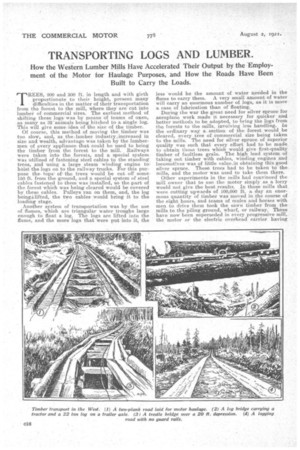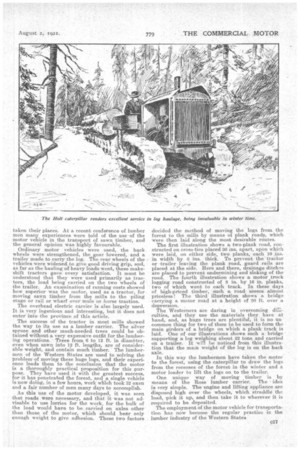TRANSPORTING LOGS AND LUMBER.
Page 12

Page 13

If you've noticed an error in this article please click here to report it so we can fix it.
How the Western Lumber Mills Have Accelerated Their Output by the 'Employment of the Motor for Haulage Purposes, and How the Roads Have Been Built to Carry the Loads.
REES, 200 and 300 ft. in length and with girth
proportionate to their height, present many difficulties in the matter of their transportation. from the forest to the mill, where they are cut into lumber of commercial sizes. The earliest method of shifting theselogs was by means of teams of oxen, as many as 32'animals being hitched to a single log. This will give some•idea of the size of the timber.
Of course, this method of moving the timber was too slow, and, as the lumber industry,increased in size and wealth, kvivantage• was taken by the lumbermen of every appliance that could be used to bring the timber from the forest to the mill. Railways were taken into the forests, and a special system was utilized of fastening steel cables to the standing trees, and using a large steam winding engine to hoist the logs on to the railway trucks. For this purpose the. tops of' the trees would be cut off some 150 ft. from the ground, and a special system of steel cables fastened to them was installed, so the part of the forest which was being cleared would be covered by these cables. Pulleys ran. on them, and, the log being4lifted, the two cables would bring it to the loading stage.
Another system of transportation was by the use of flumes, which are triangular water troughs large enough to float a log. The logs are lifted into the flume, and the more logs that were put into it, the
less would be the amount of water needed in the flume to carry them. A very small amount of water will carry an enormous number of logs, as it is more a case of lubrication than of• floating.
During the war the great need for silver spruce for aeroplane work made it necessary for quicker and • better methods to be adopted, to bring the logs from the forests to the mills, involving less handling. In the ordinary way a section of the forest would be cleared, every tree of commercial size being taken to the mills. The need for silver spruce of superior quality was such that every effort had to be made to obtain those trees which would give first-quality timber, of faultless grain. The high lead system of taking out timber with cables, winding engines and locomotives was of little value-.in obtaining this good silver spruce. These trees had to be taken to the mills, and the motor was used to take them there.
Other experiments in the mills had convinced the mill owner that to use the motor simply as a lorry would not give the best results. In those mills that. were cutting upwards of 100,000 ft. a day an enormous quantity of timber was moved in the course of the eight hours, and teams of mules and horses with men to drive them took the sawn timber from the mills to the piling ground, wharf, or railway. These have now been superseded in every progressive mill, the motor or the electric overhead carrier having
taken their places. At a recent conference of lumber men many experiences were told of the use of the -motor vehicle in the transport of sawn timber, and the general opinion was highly favourable.
. Ordinary motor vehicles were used, the back wheels were strengthened, the• gear lowered, and a trailer inade to carry the log. The rear wheels of the vehicles were widened to give good driving grip, and, as far as the hauling of heavy loads went, these makeshift tractors gave every satisfaction. It must be understood that they were used primarily as tractors, the load being carried on the two wheels of the trailer. An examination of running costs showed how superior was the motor, used as a tractor, for moving sawn timber from the mills to the piling stage or rail or wharf over mule or horse traction.
The overhead electric carrier. is also largely used. It is very ingenious and interesting, but it does not enter into the province of this article.
The success of the tractor in most mills showed the way to its use as a lumber carrier. The silver spruce and other much-needed trees could be obtained without a very expensive outfit for the lumbering operations. Trees from 6 to 12 ft. in diainter, even when sawn into 12 ft. lengths, are of considerable weight, and contain much timber. The lumbermen of the Western States are used to solving the problem of moving these huge logs, and their experience leads them to the conclusion that the motor is a thoroughly practical proposition for this purpose. They have used it with the greatest success, for it has, penetrated the forest, and a single vehicle is now doing, in a few hours, work which took 32 oxen and a fair number of men many days to accomplish.
As this use of the motor developed, it was seen that roads were necessary, and that it was not ad-visa,bIe to use lorries for the work, for the hulk of the load would have to be carried on axles other than those of the motor, which should bear only enough weight to give adhesion. These two factors
decided the method of moving the logs from the forest to the mills by means of plank roads, which were then laid along the most desirable routes.
The first illustration shows a two-plank road, constructed on cross-ties placed 30 ins, apart, upon which were laid, on either side, two planks, each 10 .ins. in width by 6 ins. thick. To prevent the tractor or• trailer leaving the plank road, guard rails are placed at the side. Here and there, drainage ditches are placed to prevent undermining and sinking of the road. The fourth illustration shows a motor truck logging road constructed of 8 in. by 16 in. planks, two of which went to each track. In these days of highcriced timber, such a road seems almost priceless! The third illustration shows a blidge carrying a motor road at a height of 20 ft. over a depression.
The Westerners are daring in overcoming dirt
culties, and they use the materials theyat hand, and, as huge trees are plentiful, itis no un common thing for two of them to be used to form the main girders of a bridge on which a plank track is laid. One of our illustrations shows such a bridge supporting a log weighing about 22 tons, and carried on a trailer. It will be noticed from this illustration that the main weight of the log is on the back axle.
In this way the lumbermen have taken the motor to the forest, using the caterpillar to draw the logs from the recesses of the forest in the winter and a motor loader to lift the logs on to the trailer.
One unique way of moving timber is by means of the Ross lumber carrier. The idea is very simple. The engine and lifting appliance are disposed high over the wheels, which straddle the load, pick it up, and then take it to wherever it is required to be deposited. The employment of the motor vehicle for transportation has now become the regular practice in the lumber industry of the Western States


































